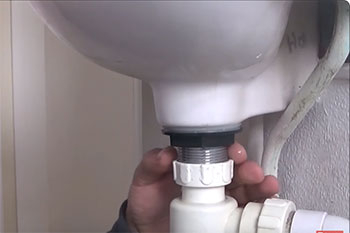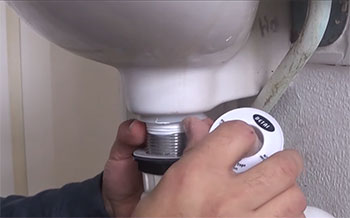Ah, the joys of homeownership! One minute, you’re basking in the glory of your beautiful bathroom oasis, and the next, you’re staring at a puddle of water slowly forming underneath your sink. Fear not, dear reader, for we’re about to embark on a journey to unravel the mystery of why your bathroom sink is leaking from below.
Whether it’s a slow drip or a steady stream, a leaky sink can be more than just a nuisance – it’s a potential recipe for water damage, mold growth, and skyrocketing utility bills. But fear not, for we’ve got your back! In this comprehensive guide, we’ll explore the most common culprits behind these pesky leaks and arm you with the knowledge to tackle them head-on.
So, grab a towel (you might need it) and let’s discuss about it!
The Usual Suspects: Common Causes of Bathroom Sink Leaks
1. Faulty Faucet Connections
Let’s start with the most obvious suspect: the faucet itself. Over time, the connections between the faucet and the water supply lines can loosen, crack, or simply wear out. This can lead to water seeping out from underneath, creating a soggy mess that no one wants to deal with.
2. Worn-Out Washers and O-Rings
Ah, the unsung heroes of the plumbing world – washers and O-rings. These tiny components play a crucial role in sealing off water flow, but like all things, they don’t last forever. As they age and deteriorate, they can cause leaks, turning your sink into a miniature waterfall.

3. Corroded Pipes and Fittings
Pipes and fittings are the veins that carry water to your sink, but they’re not immune to the ravages of time and the elements. Corrosion can cause them to develop tiny cracks or holes, allowing water to escape and wreak havoc beneath your sink.
4. Damaged Sink Basin
In some cases, the leak might not be coming from the plumbing at all, but rather from the sink basin itself. Over time, hairline cracks or chips can develop in the basin, creating a path for water to seep through and drip onto the cabinet below.
5. Clogged Drains and Overflows
While not a direct cause of leaks, clogged drains and overflows can lead to water backing up and spilling over, creating a soggy situation beneath your sink. It’s like having a party guest who overstays their welcome and makes a mess – not cool.
Quick Fixes for Bathroom Sink Leaks
1. Tighten Loose Connections

If you suspect that the leak is coming from a loose connection, grab your trusty wrench and give those fittings a gentle tightening. Just be careful not to over-tighten, as you don’t want to break anything (or end up with a plumber’s bill that makes you wish you’d never touched it).
2. Replace Worn Washers and O-Rings
If your leak seems to be originating from the faucet itself, it might be time to replace those tired old washers and O-rings. It’s a relatively inexpensive and straightforward fix that can breathe new life into your sink setup.
3. Apply Pipe Sealant or Tape
For minor leaks in pipes or fittings, a little pipe sealant or Teflon tape can work wonders. Just be sure to clean the area thoroughly before applying, and follow the manufacturer’s instructions to a tee.
4. Repair or Replace Damaged Components
If the leak is coming from a cracked or damaged sink basin, drain, or overflow, it might be time to consider a repair or replacement. While this can be a more involved (and potentially expensive) fix, it’s often the only way to truly resolve the issue.
When It’s Time to Call in the Pros
Sometimes, no matter how handy you are, a bathroom sink leak can be too complex or stubborn to tackle on your own. In cases like these, it’s best to call in a professional plumber. They have the expertise, tools, and experience to diagnose and solve even the most perplexing leaks, ensuring that your bathroom oasis remains dry and functional.
FAQ: Answering Your Burning Questions
The specific fix will depend on the cause of the leak. It could involve tightening loose connections, replacing washers or O-rings, applying sealant or tape, or repairing/replacing damaged components. If the leak persists, it’s best to call a professional plumber.
There are several potential causes, including faulty faucet connections, worn-out washers and O-rings, corroded pipes and fittings, a damaged sink basin, or clogged drains and overflows.
A leaky faucet is often the culprit behind water dripping underneath the sink. This could be due to loose connections, worn washers or O-rings, or corrosion in the faucet itself.
To pinpoint the source of a leak, start by drying the area thoroughly and monitoring where the water is dripping from. You can also check for signs of moisture, discoloration, or corrosion around pipes, fittings, and other components.
Also Read: 4 Proven Tips To Unclog A Bathtub [With Video Instructions]
Conclusion
A leaky bathroom sink can be more than just aS minor annoyance – it’s a potential gateway to water damage, mold growth, and skyrocketing utility bills. But fear not, for with the knowledge you’ve gained from this comprehensive guide, you’re now armed and ready to tackle those pesky leaks head-on.
Remember, the key to resolving a leak is identifying the root cause. Whether it’s a faulty faucet connection, worn-out washers and O-rings, corroded pipes and fittings, a damaged sink basin, or clogged drains and overflows, there’s a solution out there waiting for you.
If you’re feeling handy, try your hand at some of the quick fixes we’ve outlined, like tightening loose connections, replacing washers and O-rings, or applying pipe sealant or tape. But if the leak persists or seems too complex to tackle on your own, don’t hesitate to call in the professionals. A skilled plumber can diagnose and resolve even the most stubborn leaks, ensuring that your bathroom oasis remains dry, functional, and worry-free.
So, grab that towel (you might still need it), roll up your sleeves, and get ready to conquer those bathroom sink leaks once and for all. With a little patience, perseverance, and perhaps a dash of humor, you’ll be back to enjoying your peaceful bathroom sanctuary in no time!
